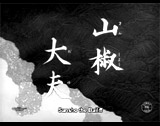
|
Sansho the Bailiff (1954, Jp.) (aka
Sanshô Dayû)
In Kenji Mizoguchi's very moving and sad drama (about
a family torn apart) - set in medieval 11th century Japan during
a time of warring social classes and rampant slavery and brutality
("an era when mankind had not yet awakened as human beings"):
- a family in 11th century feudal Japan was comprised
of the idealistic father Masauji Taira (Masao Shimizu), his wife
Tamaki (Kinuyo Tanaka), their daughter Anju (Kyôko Kagawa)
and his young son Zushiô (Yoshiaki Hanayagi)
- the virtuous, humanitarian and compassionate feudal
governor and father Masauji treated
his peasant subjects fairly (and refused to overtax them)
- before his ouster and exile, Masauji offered wise
advice to his young son Zushio - along with a small golden statue-amulet
representing the Goddess of Mercy, Kwannon: "Zushio,
I wonder if you'll become a stubborn man like me. You may be too
young to understand, but hear me out anyway. Without mercy, man
is like a beast...Even if you are hard on yourself, be merciful
to others. Men are created equal. Everyone is entitled to their
happiness"
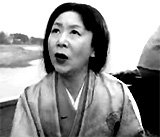
|

|
|
Lakeside Seizure of the Family
|
- the feudal governor was ousted, banished
and exiled to a remote province for not enforcing the harsh tax laws
(on rice) and the military draft; his aristocratic
family embarked on a lengthy search for him; in a devastating
sequence, the members of the family were separated during a lakeside
seizure - tricked by a priestess and sold to the estate of Sanshô (Eitarô Shindô),
a ruthless, cruel and corrupt bailiff, tax-collector and manager
of a lordship's manor, who maintained a large slave contingent;
the two children became indentured servants when sold into slavery,
and the mother Tamaki was sold into prostitution on Sado Island
- Sansho's sympathetic and kindly son Taro (Akitake
Kôno) gave the two children new names to protect their identity:
Mushu for Zushio, and Shinobu for Anju
- a new slave girl in the household brought news of
the mother (via an evocative song with the names of her children: "Zushio,
how I long for you, Anju, how I long for you") - this confirmed
that the mother (now a courtesan) was still alive; she had been given
a new name, Nakagimi; it was learned that she had made many attempts
to escape, so her captors were forced to cut her Achilles' tendons
- while enslaved in the camp's compound, Anju/Shinobu
retained her humanity, while Zushio/Mushu lost his compassion by
mercilessly punishing and executing other slaves and becoming one
of Sansho's enforcers; Zushio neglected his father's advice as he became a barbaric henchman for
Sansho and carried out murder and torture (branding the foreheads
of attempted escapees with a hot sword) of other slaves
- the use of sound joined together the mother and her
now-grown children when she realized her children were still alive
ten years later; she called to them from a hilltop: "Zushio...Anju!"
- in a tragic scene, the two children were ordered to
take a sick slave girl into the woods to die, and they decided to
make an escape attempt; Anju persuaded Zushio to flee with the sick
female, while she self-sacrificially drowned herself
(off-screen) in a lake (to avoid capture and torture - "Isn't
life torture?"); she created a diversion to save her brother by
not revealing his location, by slowly walking into deepening water;
her death was symbolized only by peaceful ripples on the lake's surface
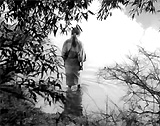
|
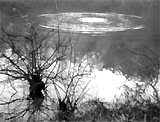
|
|
The Self-Sacrificial Drowning of Anju/Shinobu
|
- Zushio successfully escaped and hid out in a monastery
before appealing for mercy to the Emperor's
Chief Advisor in Kyoto; after being recognized as the son of a once-respected
governor, Zushio was reinstated to the position;
now elevated and converted, he was determined to criminalize slavery and fight
against injustice; during a nihilistic sequence, the former slaves
revolted and burned down Sanshô's
manor, and exiled the nefarious bailiff; later, Zushio resigned his
governorship and was determined to locate his mother
- in the film's catharctic ending, after twenty years,
Zushio and his hobbled, half-mad mother (now aged, lame and blind,
and with a shattered life) were tearfully reunited on the tsunami-devastated
beach of the island of Sado; he heard his mother's singing -
at first she didn't believe he was her son, but did identify him
by using her fingers to trace the shape of his face; then she
was saddened to hear when he revealed that both Anju and her husband
were dead: "It's just you and I. We're all alone now"
- Zushio claimed that he had
finally adopted his father's teachings: "I could have come for
you as a governor, but I gave up my title in order to follow Father's
teachings. Please, Mother, forgive me!" - she responded: "What
nonsense do you speak of? I don't know what you have done, but I
know that you followed your Father's teachings. And that is why we
have been able to meet again"
|
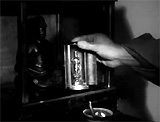
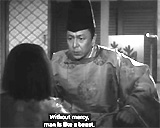
Governor and Father Masauji Offering Advice and a Small
Statue to His Young Son Zushio: ("Without mercy, man is like a beast...")
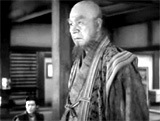
Ruthless, Cruel, and Corrupt Bailiff Sanshô (Eitarô Shindô)
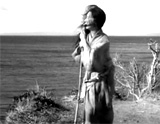
The Mother Calling For Her Now-Grown Children
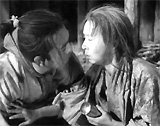
Zushio Tearfully Reunited With His Enslaved, Half-Mad
Mother
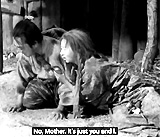
Zushio to His Mother: "It's just you and I"
|







